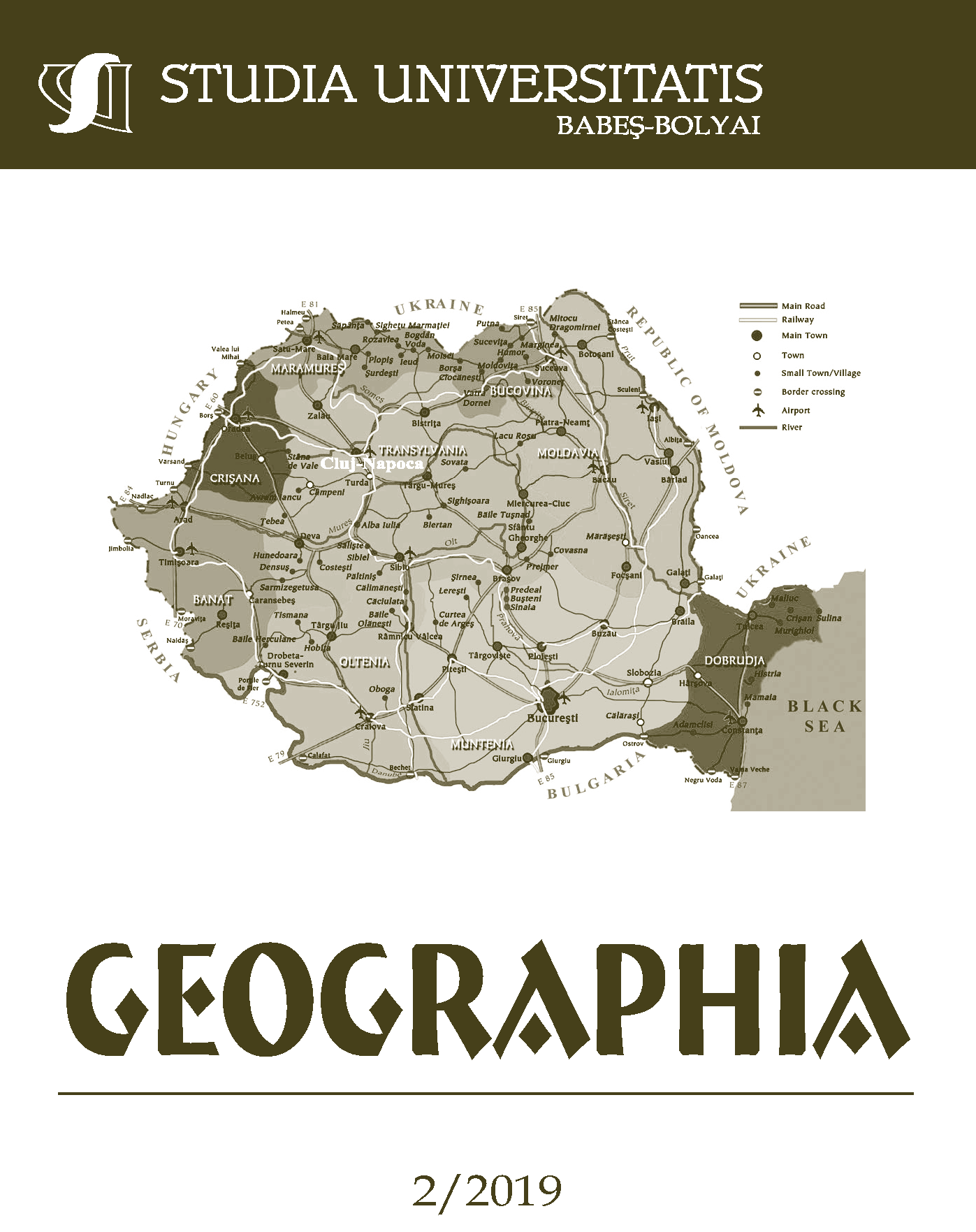THE ADMINISTRATIVE ORGANISATION OF PRESENT CLUJ COUNTY BETWEEN 1541 AND 1848
DOI:
https://doi.org/10.24193/subbgeogr.2019.2.02Keywords:
Cluj County, administrative organisation, historical counties, districts, Principality of Transylvania.Abstract
The administrative organisation is one of the most important spatial planning actions, because it directly determines spatial configurations and polarizing relations, while concentrating local government institutions into cities and towns which are becoming more prominent as a result of them being designated as administrative centres. This paper attempts to reconstruct the administrative divisions and the ranking of settlements of present Cluj County between 1541 and 1848. Included almost entirely in the Principality of Transylvania, the area of present Cluj County was mainly covered, from North to South, by the counties of Solnocu Interior (Inner Solnoc), Dăbâca, Cluj and Turda. The Szekler seat of Arieș covered a small part in the South and Bihor County (in the Kingdom of Hungary) covered a very small part in the West of present Cluj County. Their limits remained largely the same over a very long period of time. The counties of Solnocu Interior, Dăbâca, Cluj and Turda extended a lot to the West and East of present Cluj County, but their seats were all located here: Dej (Solnocu Interior County), Bonțida (Dăbâca County), Cluj and Turda, to which one may add Gherla, that had the highest status, just like Cluj, that of free royal city, and had an administration of its own. All counties were divided into two districts, an Upper District and a Lower District, and the districts, in their turn, were further divided into circles (smaller districts). Cluj, Gherla, Turda and Dej have retained their importance throughout several centuries up until today, and their historical heritage and prominence still plays an important part in the present regional framework.References
Andea, Susana (2003), Instituțiile centrale și locale în Transilvania, in Cândea, V. (coord.), Istoria Românilor, vol. V: o epocă de înnoiri în spirit European (1601-1711/1716), Academia Română, Edit. Enciclopedică, București.
Dányi, D., Dávid, Z. (1960), Az első Magyarországi népszámlálás (1784-1787), Budapest, https://library.hungaricana.hu/hu/view/NEDA_1784_elso_magyar/?pg=0&layout=s, last accessed on 11 August 2019.
Dörner, A. (2008), Structura puterii, in Pop, I.A., Nägler, T., Magyari A. (eds.), Istoria Transilvaniei. Vol. II (de la 1541 până la 1711), 2nd edition, Academia Română, Centrul de Studii Transilvane, Cluj-Napoca.
Fényes, E. (1839), Magyarországnak ‘s a’ hozzá kapcsolt tartományoknok mostani állapolja statistikai és geographiai tekintetben, I-VI, Pest.
Fényes, E. (1847), Magyarország leirása, Nyomatott Beimelnél, Pest.
Gyémánt, L., Câmpeanu, R., Dörner, A.E., Mureșan, F.V. (2009), Conscripția fiscală a Transilvaniei din anul 1750. Vol. 1: Descrierea localităților conscrise, Edit. Enciclopedică, București.
Gyémánt, L., Câmpeanu, R., Dörner, A.E., Mureșan, F.V. (2016), Conscripția fiscală a Transilvaniei din anul 1750. Vol. 2: Tabelele statistice, Edit. Enciclopedică, București.
Nicoară, T. (2001), Transilvania la începuturile timpurilor moderne (1680-1800), Edit. Dacia, Cluj-Napoca.
Pop, I.A., Nägler, T., Magyari A. (coord.) (2008a), Istoria Transilvaniei. Vol. II (de la 1541 până la 1711), 2nd edition, Academia Română, Centrul de Studii Transilvane, Cluj-Napoca.
Pop, I.A., Nägler, T., Magyari A. (coord.) (2008b), Istoria Transilvaniei. Vol. III (de la 1711 până la 1918), 2nd edition, Academia Română, Centrul de Studii Transilvane, Cluj-Napoca.
Prodan, D. (1991), Din istoria Transilvaniei: studii și evocări, Edit. Enciclopedică, București.
Puşcariu, I.S. (1864), Disertaţiune despre împărţirea politică a Ardealului, Sibiu.
Răduțiu, A., and Gyémánt, L. (1995), Repertoriul izvoarelor statistice privind Transilvania 1690-1847, Edit. Univers Enciclopedic, București.
Rusu, R. (2007), Organizarea spaţiului geografic în Banat, Bibliotheca Historica et Archaeologica Banatica XLII, Edit. Mirton, Timişoara.
Rusu, R. (2011), The Evolution of Administrative Organization in Wales. Case Study: The Former Glyndŵr District, Studia Universitatis Babeş-Bolyai, series Geographia, LVI, 2, Cluj-Napoca, pp. 151-158.
Rusu, R. (2016), Rețeaua de localități, in Benedek, J., Man, T. (coord.) Analiza geografică a structurilor teritoriale din perspectiva planificării spațiale. Județul Mureș, Edit. Presa Universitară Clujeană, Cluj-Napoca, pp. 163-248.
Varga, E. Á (2002), Erdély etnikai és felekezeti statisztikája, 1850-1992. Helységnévtár, Edit. Pro-Print, Miercurea Ciuc.
Downloads
Published
How to Cite
Issue
Section
License
Copyright (c) 2019 Studia Universitatis Babeș-Bolyai Geographia

This work is licensed under a Creative Commons Attribution-NonCommercial-NoDerivatives 4.0 International License.





 ©Studia Universitatis Babeş-Bolyai Geographia. Published by Babeș-Bolyai University.
©Studia Universitatis Babeş-Bolyai Geographia. Published by Babeș-Bolyai University.